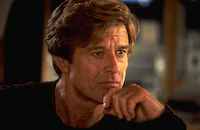Three Days of the Condor (1975) was one in a series of political conspiracy thrillers to appear in the wake of the Watergate scandals. Other well-known examples include The Parallax View (1974) and All the President's Men (1976), both directed by Alan J. Pakula. At the time Three Days of the Condor grossed more than $20 million, testifying to the film's success as a tightly crafted thriller. However, like many of the political thrillers of the day, it also offers serious commentary on the corrupting influence of power. In light of recent events such as the Iran-Contra scandal and the Persian Gulf War, today the film's resolution seems more disturbingly plausible than ever.
James Grady, author of the 1974 novel Six Days of the Condor on which the film is based, was born in Montana and earned a degree in Journalism from the University of Montana. He then moved to Washington D.C., where he served as an aide to U.S. Senator Lee Metcalf and worked as an investigative reporter to noted newspaper columnist Jack Anderson. After the success of Six Days of the Condor, which has been translated into a number of languages, he published a sequel, Shadow of the Condor (1975). Recent novels by Grady include Thunder (1994) and White Flame (1996).
Director Sydney Pollack and star Robert Redford have had a long and fruitful collaboration, starting with the Tennessee Williams adaptation This Property is Condemned (1966) and continuing through Havana (1990) for a total of seven films. The Way We Were (1973), in particular, was one of the most popular films of its decade.
Three Days of the Condor was shot on location in New York in the fall of 1974. Because the film was supposed to be set in the middle of winter, leaves had to be removed from the trees on the streets where the film was shot. Faye Dunaway, who was to be held hostage by Robert Redford according to the screenplay, was required to display fear that she might be raped. However, Dunaway, who had long dreamed of playing opposite Redford, had difficulty not breaking into laughter during the shoot. "Now I'm sorry," she says in her memoir Looking for Gatsby, "but the idea of being kidnapped and ravaged by Robert Redford was anything but frightening." When Redford left the set temporarily, the director Pollack took over: "The cameras were rolling, I was in position, and suddenly Sydney lunged at me, growling 'I AM GOING TO GET YOU!' I'm tied up at this point, unable to get away or move much at all, but Sydney kept moving toward me, his eyes glaring at me as he went on detailing all the horrible things he was going to do to me, and let me tell you, Sydney has an inventive mind. He is also a great actor, and he scared the hell out of me. Sydney kept the camera rolling and he was relentless."
Director: Sydney Pollack
Producer: Stanley Schneider
Screenplay: Lorenzo Semple, Jr. and David Rayfiel, adapted from the novel Six Days of the Condor by James Grady
Cinematography: Owen Roizman
Editing: Fredric Steinkamp and Donald Guidice
Music: Dave Grusin
Art Direction: Gene Rudolf
Principal Cast: Robert Redford (Joe Turner), Faye Dunaway (Kathy Hale), Cliff Robertson (Higgins), Max von Sydow (Joubert), John Houseman (Mr. Wabash), Addison Powell (Atwood), Walter McGinn (Sam Barber), Tina Chen (Janice), Michael Kane (Wicks).
C-118m. Letterboxed.
by James Steffen



























